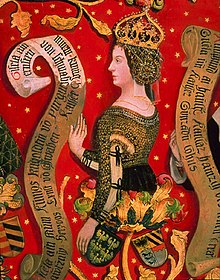Gisela of Swabia
| Gisela of Swabia | |
|---|---|

Depiction in the Babenberg family tree at Klosterneuburg Monastery, c. 1490
|
|
| Empress consort of the Holy Roman Empire | |
| Reign | 1027–1039 |
| Coronation | 26 March 1027 St. Peter's Basilica, Rome |
| Queen consort of Germany | |
| Reign | 1024–1039 |
| Coronation | 21 September 1024 Cologne Cathedral |
| Born | 11 November 990 |
| Died | 14 February 1043 Imperial Palace of Goslar, Saxony |
| Burial | Speyer Cathedral |
| Spouse |
Brun I, Count of Brunswick Ernest I, Duke of Swabia Conrad II, Holy Roman Emperor |
| Issue more... |
Liudolf, Margrave of Frisia Ernest II, Duke of Swabia Herman IV, Duke of Swabia Henry III, Holy Roman Emperor Matilda of Franconia |
| House | Conradines |
| Father | Herman II, Duke of Swabia |
| Mother | Gerberga of Burgundy |
Gisela of Swabia (11 November 990 – 14 February 1043), a member of the Conradiner dynasty, was Queen consort of Germany from 1024 to 1039 and Empress consort of the Holy Roman Empire from 1027 to 1039 by her third marriage with Emperor Conrad II. She was the mother of Emperor Henry III. She was regent of Swavia for her minor son Duke Ernest II of Swabia in 1015.
Gisela was the daughter of Duke Herman II of Swabia and Gerberga of Burgundy, daughter of King Conrad the Peaceful. Both her parents were descendants of Charlemagne.
She first married the Saxon count Brun I of Brunswick, about 1002. Upon Brun's death, her second marriage was ca. 1012 with the Babenberg scion Ernest, who had been enfeoffed with the Duchy of Swabia by King Henry II at the death of Gisela's brother, Duke Herman III and aimed at legitimising himself as his heir. After Ernest's early death in 1015, Gisela became regent for their minor son Duke Ernest II of Swabia (Herzog Ernst). She was then removed from the regency by her third husband on grounds of her being too closely related to the late Babenberg duke, an incident which later led to a major conflict between Ernest II and his stepfather.
Her third marriage, who took place before January 1017, was to Conrad II, who was elected King of the Romans in 1024 and became Holy Roman Emperor in 1027. According to Thietmar of Merseburg, Archbishop Aribo of Mainz refused to crown her Queen of Germany, as he stated Gisela and Conrad were too closely related. Nevertheless, thirteen days after his coronation, Archbishop Pilgrim of Cologne crowned her instead.
...
Wikipedia
